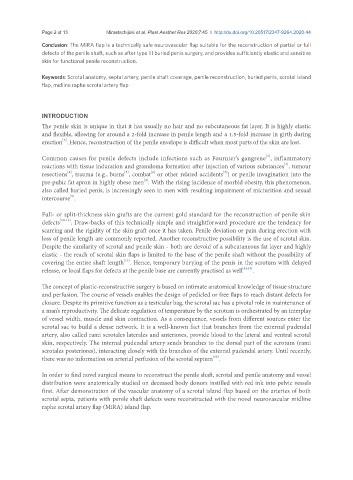Page 503 - Read Online
P. 503
Page 2 of 13 Mirastschijski et al. Plast Aesthet Res 2020;7:45 I http://dx.doi.org/10.20517/2347-9264.2020.44
Conclusion: The MiRA flap is a technically safe neurovascular flap suitable for the reconstruction of partial or full
defects of the penile shaft, such as after type III buried penis surgery, and provides sufficiently elastic and sensitive
skin for functional penile reconstruction.
Keywords: Scrotal anatomy, septal artery, penile shaft coverage, penile reconstruction, buried penis, scrotal island
flap, midline raphe scrotal artery flap
INTRODUCTION
The penile skin is unique in that it has usually no hair and no subcutaneous fat layer. It is highly elastic
and flexible, allowing for around a 2-fold increase in penile length and a 1.5-fold increase in girth during
[1]
erection . Hence, reconstruction of the penile envelope is difficult when most parts of the skin are lost.
[2]
Common causes for penile defects include infections such as Fournier’s gangrene , inflammatory
reactions with tissue induration and granuloma formation after injection of various substances , tumour
[3]
[4]
[5]
[7]
[6]
resections , trauma (e.g., burns , combat or other related accidents ) or penile invagination into the
pre-pubic fat apron in highly obese men . With the rising incidence of morbid obesity, this phenomenon,
[8]
also called buried penis, is increasingly seen in men with resulting impairment of micturition and sexual
[9]
intercourse .
Full- or split-thickness skin grafts are the current gold standard for the reconstruction of penile skin
defects [10-12] . Draw-backs of this technically simple and straightforward procedure are the tendency for
scarring and the rigidity of the skin graft once it has taken. Penile deviation or pain during erection with
loss of penile length are commonly reported. Another reconstructive possibility is the use of scrotal skin.
Despite the similarity of scrotal and penile skin - both are devoid of a subcutaneous fat layer and highly
elastic - the reach of scrotal skin flaps is limited to the base of the penile shaft without the possibility of
covering the entire shaft length . Hence, temporary burying of the penis in the scrotum with delayed
[13]
release, or local flaps for defects at the penile base are currently practised as well [14,15] .
The concept of plastic-reconstructive surgery is based on intimate anatomical knowledge of tissue structure
and perfusion. The course of vessels enables the design of pedicled or free flaps to reach distant defects for
closure. Despite its primitive function as a testicular bag, the scrotal sac has a pivotal role in maintenance of
a man’s reproductivity. The delicate regulation of temperature by the scrotum is orchestrated by an interplay
of vessel width, muscle and skin contraction. As a consequence, vessels from different sources enter the
scrotal sac to build a dense network. It is a well-known fact that branches from the external pudendal
artery, also called rami scrotales laterales and anteriores, provide blood to the lateral and ventral scrotal
skin, respectively. The internal pudendal artery sends branches to the dorsal part of the scrotum (rami
scrotales posteriores), interacting closely with the branches of the external pudendal artery. Until recently,
[16]
there was no information on arterial perfusion of the scrotal septum .
In order to find novel surgical means to reconstruct the penile shaft, scrotal and penile anatomy and vessel
distribution were anatomically studied on deceased body donors instilled with red ink into pelvic vessels
first. After demonstration of the vascular anatomy of a scrotal island flap based on the arteries of both
scrotal septa, patients with penile shaft defects were reconstructed with the novel neurovascular midline
raphe scrotal artery flap (MiRA) island flap.

